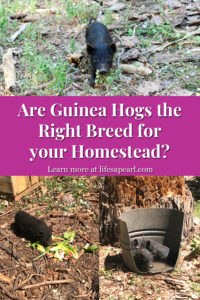We have our first animal additions to the homestead! About three weeks ago, we brought three American Guinea Hogs onto the property.
I never would have guessed our first livestock animal would be a pig. I honestly thought we would start with chickens and work our way up to bigger animals. But there are many reasons why we made the jump straight into raising hogs.
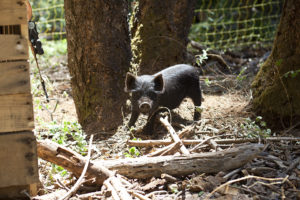
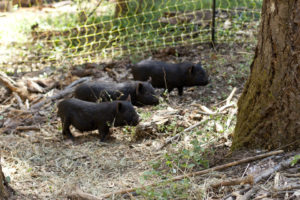
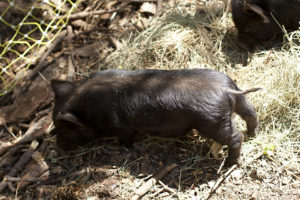
Mainly we got tired of pulling up poison oak by hand. Poison oak pops up all over the place in our area and the strain on our property is particularly potent. We’ve been clearing it out of our first development area where we’ll have a garden and a yard for Pearl.
My husband is terribly allergic to poison oak. He often has to go get a shot of steroids when he’s exposed. I’m not sure which is worse, the medication or the many layers he has to wear to go out and work on our property. Not so bad in winter but suffocating in the summer.
On the other hand, I’m lucky not to react to the urushoil – most of the time. This time though even I had a couple rash spots appear on my arms after a week of pulling up the vines and roots.
Plus the squatting and bending is especially tiring when pregnant. I’m just hoping if there are any antibodies involved, the baby might be more likely to take after me and not have allergic reactions!
So when my husband thought smarter not harder and became serious about getting animals to help, I was all for it!
American Guinea Hogs
American Guinea Hogs are thought to be the perfect homestead pig. This heritage breed was down to less than 100 pigs in the United States during the 1990s.
It’s still classified by the Livestock Conservancy as a threatened breed. But the breed is making a comeback! Mostly thanks to small family farms and a growing interest in sustainably raised meat.
Guinea Hogs are truly a dual purpose pig. They’re amazing foragers and do very well on pasture. They require a lot less supplemental feed than most other breeds. Overfeeding them on grain is even easy to do and can cause them health issues.
Our pigs are loving eating the poison oak – it’s often their first choice in a new area! They also enjoy acorns, kitchen scraps – especially watermelon rinds – and some alfalfa when we had them in the smaller area.
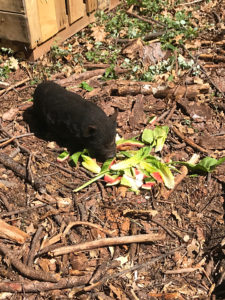
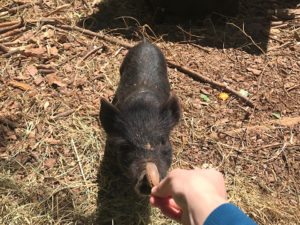
American Guinea Hogs are a smaller breed pig, growing anywhere from 150 to 250 pounds. That in combination with their docile disposition makes them easy to manage. Especially for someone just starting out. They also do well with children and can even be kept in pastures with other types of animals.
These pigs are a hardy breed adapted to a large variety of climates and temperatures. They do well both in the humid South and the dry heat of the West Coast. Having shade, water, and an area for wallowing is important to keep them healthy and comfortable in a variety of summer weather.
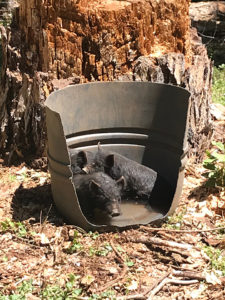
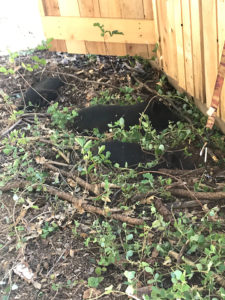
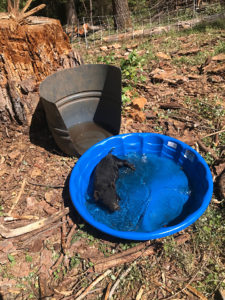
The Meat Side
Guinea hogs are slow growing. Compared to most other breeds, they take a long time to reach butchering weight. This can be seen as a benefit or a drawback depending on your needs.
For us the 18 months until they get to that size will be spent foraging and helping convert some of our land. That’s a huge plus! For those wanting the whole process to be accomplished in 6 to 9 months as is common with conventional breeds, this is a major hindrance.
Guinea hogs are considered a lard breed rather than a meat pig. Not only does that lend itself to meat that’s rich in fat and flavorful, but it’s also a benefit for those who render fat to use in everyday cooking. I’ve heard amazing things about the bacon that comes from this breed. The muscle to fat ratio is also ideal for charcuterie.
Depending on when you choose to butcher, one American Guinea Hog will yield between 60 to 80 pounds of pork. This is a manageable amount of meat for one family’s freezer. Another reason homesteaders like this breed is their size makes home processing easier.
Our Pigs
Our pigs were ten weeks old when we got them and maybe 10 pounds. We have portable electric fencing for moving them around the property. They were so small that the first thing they did was squeeze through the openings in the fence we had ready to go. So we had to set up the smaller one meant for poultry. They got settled in that for a little while and now have a larger area with the original fence to forage in during the day.
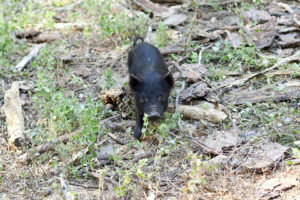
My husband also build a small house for them that he can pull behind the quad when it needs moving. He put auger anchors in the ground to hold a strap across the top so it can’t easily be flipped up. We have bears and mountain lions around so we needed an enclosed structure to keep them safe at night.
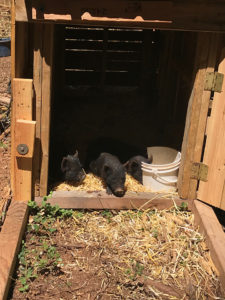
A lot of Firsts
Within the first week, we actually had a mama bear and two cubs on the property. Another first for us. She was searching for grubs under the bark of a fallen tree and wasn’t interested in the pigs. Luckily they’d already bedded down for the night and wisely didn’t come out of their house since we hadn’t locked it up yet. It’s just that time of year around here so I think it was a coincidence.
We castrated the pigs their first weekend here. The breeder told us we were getting one female and two males. We were each handed a squealing squirming pig and I was eager to get them into the crate in the back of the truck before one wriggled loose. If you care about sex, definitely check for yourself before you take them. We wound up with three males.
Since a friend had already journeyed out to help, they all got castrated even though they were the same sex. It seemed to me like it might help with keeping them docile and also preventing competition with each other.
Boar taint in the meat was also a consideration. It seems that guinea hogs aren’t affected by this either way but a lot of butchers will not touch an intact male so it seemed safer to keep our options open.
These guys are super sweet and we have gotten so much enjoyment already from what we call pig TV. They come out to greet us now whenever we’re nearby. We can feed them by hand if we want – the biggest one has become a bit nippy for that. They still squeal bloody murder if picked up. Pearl likes watching them too when they aren’t being fed.

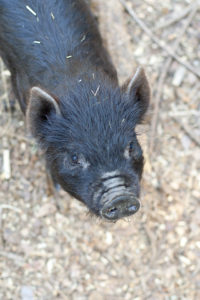
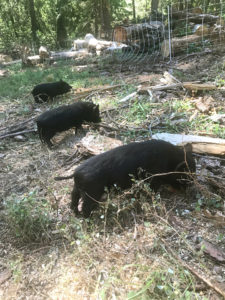
Confession of a Former Vegetarian
These are actually my first livestock animals period. As an animal lover and former vegetarian some people in my life have been concerned I’ll get too attached to the pigs. But as cute as these guys are, they’re not pets.
The pigs serve a purpose and have a job to do on our homestead. They’re doing exceptionally well too. I thought with their small size it would take awhile for them to be able to clear areas.
For me, it’s more important to practice and support those who raise food – including meat – in a sustainable humane way. That’s how we vote for change with our dollars. I’ve read it actually makes a larger impact on factory farming to buy from farmers using sustainable methods versus opting out of eating meat entirely.
What would your first livestock animal be? Do you have any experience with American Guinea Hogs?
